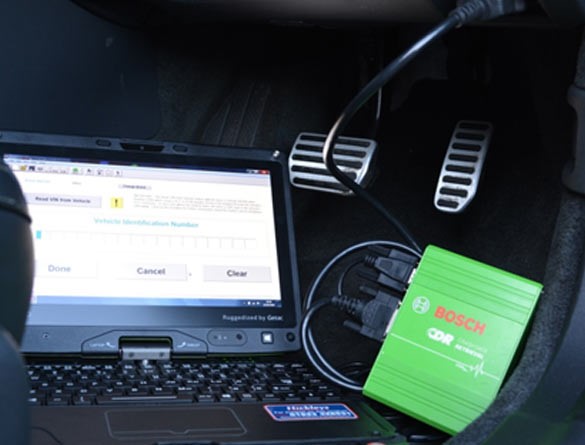Introduced in the 1970s and present in most new vehicles manufactured today, EDRs are the equivalent of a black box, recording a range of data from safety systems fitted to the vehicle in the seconds before, during and after a collision.
Modern vehicles are fitted with a vast number of sensors and modules that record information about the vehicle, such as engine and performance data, anti-lock braking system (ABS) information, Supplemental Restraint System (SRS, e.g. airbag) information, stability control and almost all systems on the vehicle.
Where is it stored?
The data is stored in the airbag control module (ACM), which also controls the restraint systems including airbags and pre-tensioners.
What data is stored?
There are 9 mandatory data elements, each with a minimum sampling rate and a standardised format. These include speed of the vehicle, whether the brakes were applied, the engine throttle and seatbelt status. However, there are many more elements that could potentially be recorded.
Making sure we have all this information early on avoids duplication of effort and minimises the need for assumptions. In the long run this saves you time and money, as well as getting you the best results.
When is it stored?
When an ‘event’ occurs, i.e. where a pre-defined threshold is exceeded. An ‘event’ doesn’t necessarily have to be a high-speed impact with catastrophic damage. In general terms, if the airbags deploy (i.e. a deployment event), it will certainly record. However, it is possible for the pre-determined thresholds to be exceeded without the airbags deploying (i.e. a non-deployment event). In this case, data will still be recorded.
Is there a time limit to retrieve the data?
The retrievability of the data depends upon whether it was a ‘deployment’ or ‘non-deployment’ event. For a deployment event, the data is locked and cannot be overwritten – therefore, there is no time limit. However, a ‘non-deployment’ event can and will be overwritten when another event occurs – therefore, time is of the essence.
Are there any regulations?
This is one of the biggest problem areas when it comes to EDR data. In the US, EDRs are required by law and have been regulated since 2010. Federal Regulations give strict requirements in relation to what the data must contain, how long it records for and how it is accessed.
Currently in the EU there are no requirements, which means that even though data is recorded, it is not accessible. Currently, manufacturers aren’t required to provide EDR data to authorities, road safety researchers or even vehicle owners. However, as part of the update to the General Safety Regulations, in 2022 all new vehicles must have an EDR fitted and allow the EDR data to be accessed – though only for road safety research purposes.
Who owns the data?
Data ownership is a common problem area and, unfortunately, EDRs are no different. According to the European Parliament, the VIN (Vehicle Identification Number) is considered to be personal data, therefore the issue of ownership is extremely important. In the US, it is determined by State and Federal Law but generally the ruling is that the owner of the vehicle is the owner of the data.
If the vehicle is leased, as many new vehicles are, is it the driver or the lease company that owns the data? What about the manufacturer? Or the insurance company? There are discussions currently taking place in relation to ownership which will hopefully bring more clarity to this area in the near future.
Is the data reliable?
The Federal Regulations in the US govern the reliability of the data – so yes, it is reliable. However, this doesn’t mean that it is without its problems and it is therefore critical that the data is analysed only by a qualified expert.
How do I know the data is from this collision?
In short, you don’t. Vehicles do not work by dates and times; all of the EDR data is recorded relative to the trigger point. So, it is not as simple as taking the most recent event and assuming that it is from the collision – instead, the analyst must examine the data to see if it corresponds to other evidence available.
Are all vehicles compatible?
The list of supported vehicles in the UK is still reasonably small but is increasing all the time. Toyota is the most common in the UK, with many vehicles from the early 2000s being compatible. All Volvos are compatible (from around 2011), and all Jeeps (from 2006 onwards). However, with impending regulations, more and more manufacturers are allowing access to the data, including VW and Audi, but only for their newest vehicles.
How is the data downloaded?
The data is downloaded from the ACM using the Bosch Crash Data Retrieval Tool, or CDR. This is a small green box that plugs into the vehicle and a computer, which decodes the digital data into a readable format. The result is a PDF report, containing all of the data from the EDR.
Here at TRL, we are raising awareness, knowledge and understanding around EDRs and their value to the investigation and reconstruction of collisions. To read an additional article on EDRs and the importance of this data, authored by Dean Beaumont, please visit







